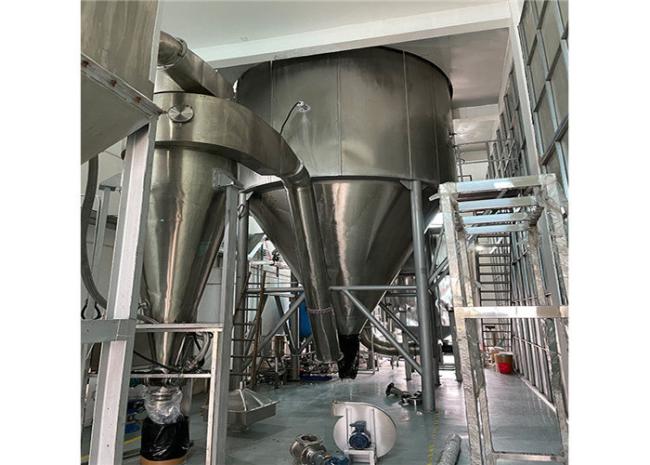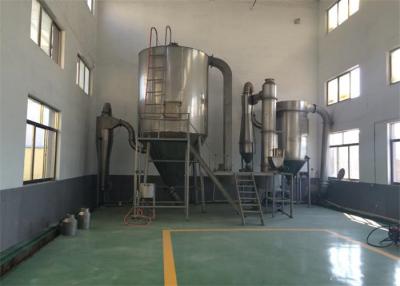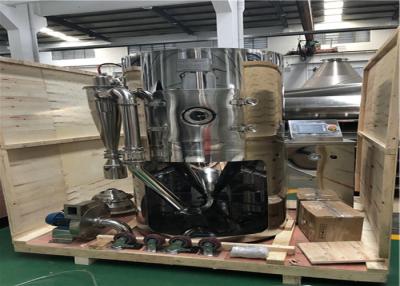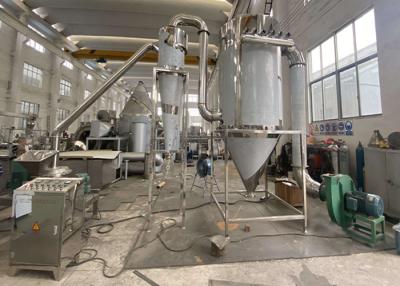50kg/h
spray
dryer
used
in
the
production
of
powdered
seasoning
or
condiments
Product
Description:
A
spray
dryer
can
also
be
used
in
the
production
of
powdered
seasoning
or
condiments.
The
process
is
similar
to
the
one
described
earlier
for
coffee
and
tea.
Here's
how
a
spray
dryer
can
be
utilized
for
seasoning
or
condiment
production:
-
Preparation
of
the
liquid
mixture:
The
ingredients
for
the
seasoning
or
condiment,
such
as
herbs,
spices,
flavorings,
and
liquid
components,
are
mixed
together
to
form
a
liquid
mixture.
This
mixture
can
include
water,
oils,
or
other
liquids
depending
on
the
specific
recipe.
-
Atomization:
The
liquid
mixture
is
pumped
into
the
spray
dryer,
where
it
is
atomized
into
small
droplets.
This
can
be
done
using
a
nozzle
or
rotary
atomizer,
similar
to
the
process
described
earlier.
-
Drying:
The
atomized
droplets
enter
the
drying
chamber
of
the
spray
dryer,
where
they
come
into
contact
with
a
stream
of
hot
air.
The
hot
air
quickly
evaporates
the
liquid
component
of
the
droplets,
leaving
behind
dried
particles.
-
Powder
collection:
The
dried
particles,
now
in
powder
form,
are
collected
from
the
bottom
or
cyclone
separator
of
the
spray
dryer.
These
particles
constitute
the
powdered
seasoning
or
condiment.
Features:
By
utilizing
a
spray
dryer
for
seasoning
or
condiment
production,
the
following
benefits
can
be
achieved:
-
Improved
shelf
life:
The
low
moisture
content
in
the
powdered
form
helps
to
enhance
the
stability
and
extend
the
shelf
life
of
the
seasoning
or
condiment.
-
Homogeneous
distribution:
Spray
drying
ensures
uniform
drying
and
particle
size
distribution,
resulting
in
a
consistent
product
with
even
flavor
distribution.
-
Ease
of
handling
and
packaging:
Powdered
seasoning
or
condiments
are
typically
easier
to
handle,
package,
and
distribute
compared
to
liquid
or
paste
forms.
-
Enhanced
solubility
or
dispersion:
Spray-dried
powders
often
exhibit
improved
solubility
or
dispersion
characteristics,
making
them
easier
to
incorporate
into
various
food
products.
-
It's
important
to
note
that
the
specific
parameters
and
conditions
during
spray
drying,
such
as
temperature,
airflow,
and
nozzle
design,
can
be
adjusted
to
meet
the
requirements
of
different
seasoning
or
condiment
formulations.
-
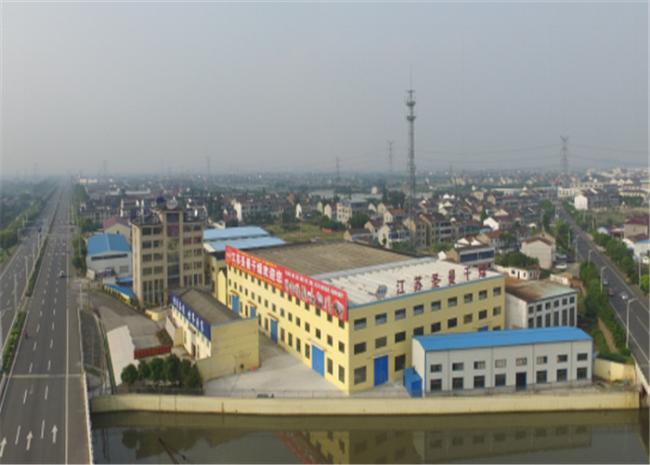
Technical
Parameters:
|
Model
|
PLG
|
|
5
|
25
|
50
|
100
|
150
|
200-2000
|
|
inlet
temperatyre
℃
|
140-350
automatically
controlled
|
|
outlet
temperatyre
℃
|
80-90
|
|
Max
water
evaporation
capacity
kg/h
|
5
|
25
|
50
|
100
|
150
|
200-2000
|
|
centrifugal
spraying
nozzle
transmission
mode
|
compressed
air
transmission
|
mechaical
transmission
|
|
rotation
speed
(r.p.m)
|
25000
|
18000
|
18000
|
18000
|
15000
|
8000-15000
|
|
spraying
desc
diameter
(mm)
|
50
|
100
|
120
|
140
|
150
|
180-340
|
|
max
electric
heating
power
(kw)
|
9
|
36
|
63
|
81
|
99
|
settled
by
customer
|
|
overall
dimensions
|
1.8*0.93*2.2
|
3*2.7*4.26
|
3.7*3.2*5.1
|
4.6*4.2*6
|
5.5*4.5*7
|
depends
on
tryer
|
|
dried
powder
collection
|
≥95
|
≥95
|
≥95
|
≥95
|
≥95
|
≥95
|
The
specific
parameters
that
can
be
adjusted
in
a
spray
dryer
for
seasoning
or
condiment
production
depend
on
the
desired
characteristics
of
the
final
product.
Here
are
some
key
parameters
that
can
be
modified:
-
Inlet
temperature:
The
inlet
temperature
of
the
hot
air
stream
in
the
spray
dryer
affects
the
drying
rate
and
moisture
removal.
Higher
temperatures
can
result
in
faster
drying
but
may
also
increase
the
risk
of
flavor
or
aroma
loss
or
degradation.
The
appropriate
temperature
range
is
determined
based
on
the
specific
seasoning
or
condiment
formulation.
-
Airflow
rate:
The
airflow
rate
within
the
drying
chamber
affects
the
residence
time
of
the
droplets,
which
in
turn
influences
the
drying
efficiency.
Adjusting
the
airflow
rate
allows
for
control
over
the
drying
kinetics
and
particle
size
distribution.
-
Nozzle
design
and
atomization:
The
type
and
design
of
the
atomization
nozzle
or
rotary
atomizer
used
in
the
spray
dryer
can
impact
the
droplet
size
and
distribution.
Different
nozzle
designs
can
be
employed
to
achieve
specific
particle
sizes
or
to
control
the
spray
pattern.
-
Feed
rate:
The
rate
at
which
the
liquid
mixture
is
fed
into
the
spray
dryer
affects
the
droplet
size
and
the
overall
drying
efficiency.
Adjusting
the
feed
rate
allows
for
control
over
the
final
particle
size
and
production
capacity.
-
Residence
time:
The
residence
time
of
the
droplets
in
the
drying
chamber
is
influenced
by
the
airflow
rate,
inlet
temperature,
and
feed
rate.
It
is
critical
to
ensure
that
the
droplets
have
sufficient
time
within
the
drying
chamber
to
achieve
complete
drying
without
excessive
exposure
to
high
temperatures.
-
Particle
collection
system:
The
choice
of
particle
collection
system,
such
as
a
cyclone
separator
or
bag
filter,
can
influence
the
separation
efficiency
and
the
quality
of
the
final
powdered
product.
The
collection
system
should
be
optimized
to
minimize
product
losses
and
maintain
the
desired
particle
characteristics.
It's
important
to
note
that
the
optimal
parameter
settings
may
vary
for
different
seasoning
or
condiment
formulations,
as
each
formulation
may
have
specific
requirements
in
terms
of
moisture
content,
particle
size,
and
flavor
stability.
Process
development
and
optimization
are
typically
carried
out
to
determine
the
most
suitable
parameter
adjustments
for
a
specific
seasoning
or
condiment
product.
